THE CENTRAL AMERICAN ART INSTITUTE (ICAC) OF THE REINA SOFIA MUSEUM IS BORN
Madrid's Reina Sofia Museum, in collaboration with the Reina Sofia Museum Foundation, reinforces its growing involvement and strategy for the dissemination and study of Latin American contemporary art with the creation of the Cáder Institute of Central American Art (ICAC), dedicated to the research and dissemination of Central American art.
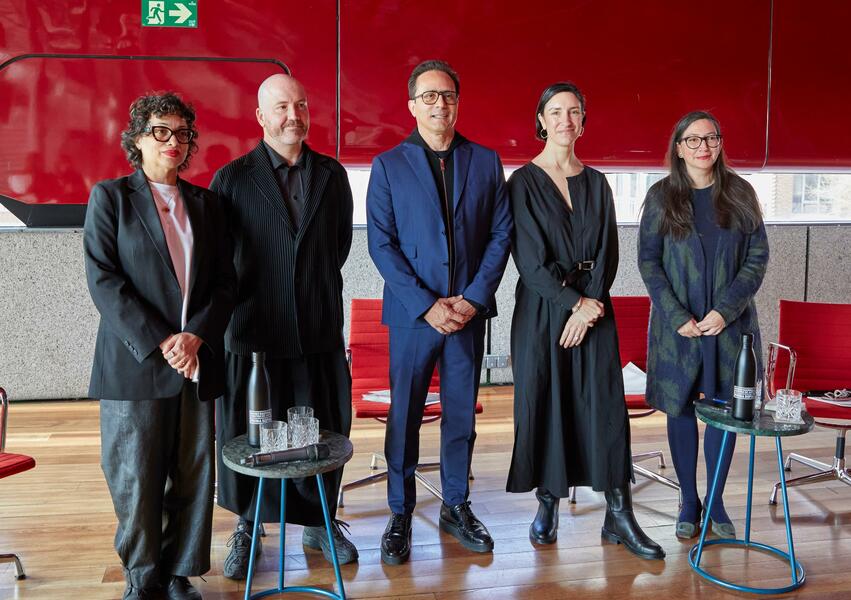
The institute, promoted by Salvadoran Mario Cáder-Frech, one of the most renowned agents in cultural management, collecting and dissemination of Central American art and awarded last year by Spain's ARCO Foundation, aims to become a space where critical lines of thought, artists and researchers converge to work on the relevance and positioning of contemporary art in and about Costa Rica, El Salvador, Guatemala, Honduras, Nicaragua and Panama, and with a special call to the diasporas and their specific production.
Cáder-Frech himself commented at the presentation of the initiative at the Reina Sofia Museum that one of the main objectives is “to ensure that the voices of Central American artists are also part of the dialogue of contemporary art” and that the collaboration of the Spanish art gallery as a partner in this venture is essential, both for its experience in the museum field and for the work developed in these areas.
-
Amanda de la Garza y Manuel Segade, sub-directora y director del museo; el salvadoreño Mario Cader-Frech; Julia Morandeira Arrizabalaga, directora de Estudio del museo; y Carolina González Castro, directora de la Fundación Museo Reina Sofia. Cortesía del Museo Reina Sofía
-
Amanda de la Garza y Manuel Segade, sub-directora y director del museo; el salvadoreño Mario Cader-Frech; Julia Morandeira Arrizabalaga, directora de Estudio del museo; y Carolina González Castro, directora de la Fundación Museo Reina Sofia. Cortesía del Museo Reina Sofía
The initiative is being presented now, but its genesis dates back to the beginning of this century, with the creation of exhibitions and spaces in the consular offices of El Salvador in the United States. “This is a process that goes back 25 years,” says Cáder-Frech, “when I observed the need in El Salvador and in the Central American region to support young, conceptual, contemporary artists. There was no government institution that could support artists to be able to go abroad and participate in international biennials, and with several friends, we made a list of everything that would have to be done to fill that void”.
That first phase lasted for a decade, right up to the inauguration of MARTE, the first art museum in El Salvador, where the process was reversed, in a way. “We began to bring international and renowned artists to El Salvador, to exhibit in the museum,” recalls Cáder-Frech, “and during their stay they would produce their works in collaboration and with the support of local artists, so that they could begin to have a relationship with international artists and see how they worked. It was a cultural exchange”.
Without losing sight of the list of needs, Yes! Contemporary (Young El Salvador) was developed, a program without borders and without physical space that focuses on the Salvadoran diaspora, which still has some reflection in the ICAC: it aims to maintain a concrete line on the Central American communities in other countries, but also claims that diffuse localization: “We learned from Yes! to take this whole process to an institution in the world, which was someone who understood the importance that it is a program that has to exist in and for the region, no matter where it is physically. It doesn't matter where the headquarters is, and the fact of being in a headquarters that has tentacles and is contemporary is what is relevant for us to have the infrastructure that an institution offers you”, Cáder-Frech points out.
-
EDGAR CALEL. B ‘ATZ tejido constelación de saberes, 2015. Impresión digital. Museo Nacional Centro de Arte Reina Sofía. Depósito indefinido de la Fundación Museo Reina Sofía, 2020 (Donación de Mario Cáder Frech). Archivo fotográfico del Museo Reina Sofía
-
EDGAR CALEL. B ‘ATZ tejido constelación de saberes, 2015. Impresión digital. Museo Nacional Centro de Arte Reina Sofía. Depósito indefinido de la Fundación Museo Reina Sofía, 2020 (Donación de Mario Cáder Frech). Archivo fotográfico del Museo Reina Sofía
-
NAUFUS RAMÍREZ- FIGUEROA. Lugar de consuelo, 2020. Video, color, sonido, 35’26”. Museo Nacional Centro de Arte Reina Sofía. Depósito indefinido de la Fundación Museo Reina Sofía, 2022. (Donación de Francesca Thyssen- Bornemisza)
The development of the ICAC in Madrid obviously maintains a certain link with Ibero-America, but it should also be understood as an opportunity that does not advocate “having a hierarchical intention” and more for betting on a space “that builds knowledge and helps us to look at each other as equals,” says Amanda de la Garza, deputy artistic director of the Museo Nacional Centro de Arte Reina Sofia.
Thus, the ICAC will have different study programs and a specific work to take advantage of the connection of international networks and societies, those “tentacles”, as defined by Manuel Segade, director of the Museum, and that will allow strengthening the exhibition and visibility of the work of the Institute and of Central American contemporary art “as a reference of its kind, since there is currently nothing similar to study the art of the region”. The Museum's role will also be consolidated as a promoter of dialogues and cooperation between Central American and global institutions.
A residency program will also be developed for researchers of Central American origin to delve, first hand, into the needs of the art scenes in the region, as well as to define and draw new narratives and analysis. Another of the instruments that the ICAC will have at its disposal will be the Collections and Library of the Reina Sofia Museum, departments that will focus on the acquisition, research and activation of the production of Central American artists or artists of their diaspora included or framed in the Collections of the Reina Sofia Museum.
Related Topics
May interest you
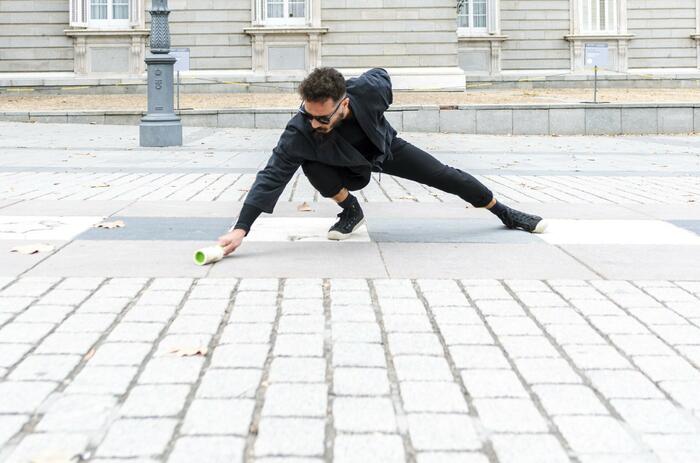
Intricate between action and register, El Apartamento hosts Algo deja quien se va, the first solo exhibition in Spain by Reynier Leyva Novo (Havana, Cuba, 1983). Starting from the political concept of historical memory and linking it to the issues of power and colonialism, the artist unfolds in two well-differentiated series his proposal to approach these lines, and extends his networks to the impact (or influence) they have on the institutional and cultural fabric.
LEYVA NOVO: DUST IT IS AND TO DUST IT WILL TURN
Intricate between action and register, El Apartamento hosts Algo deja quien se va, the first solo exhibition in Spain by Reynier Leyva Novo (Havana, Cuba, 1983). Starting from the political concept of historical memory and linking it to the issues of power and colonialism, the artist unfolds in two well-differentiated series his proposal to approach these lines, and extends his networks to the impact (or influence) they have on the institutional and cultural fabric.

Intricate between action and register, El Apartamento hosts Algo deja quien se va, the first solo exhibition in Spain by Reynier Leyva Novo (Havana, Cuba, 1983). Starting from the political concept of historical memory and linking it to the issues of power and colonialism, the artist unfolds in two well-differentiated series his proposal to approach these lines, and extends his networks to the impact (or influence) they have on the institutional and cultural fabric.
LEYVA NOVO: DUST IT IS AND TO DUST IT WILL TURN
Intricate between action and register, El Apartamento hosts Algo deja quien se va, the first solo exhibition in Spain by Reynier Leyva Novo (Havana, Cuba, 1983). Starting from the political concept of historical memory and linking it to the issues of power and colonialism, the artist unfolds in two well-differentiated series his proposal to approach these lines, and extends his networks to the impact (or influence) they have on the institutional and cultural fabric.
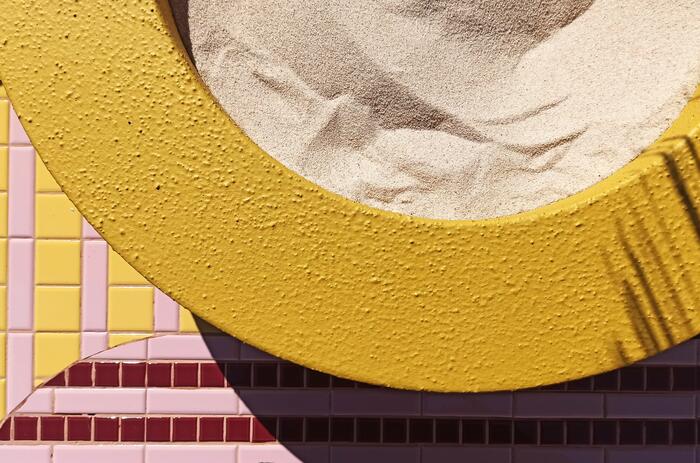
The intervention Wasi Llamkha (Place and touch), by artist Andrea Canepa (Lima, Peru, 1980), stands on the South Patio of Madrid's Condeduque. This pavilion, designed as an ephemeral architectural structure, invites us to explore its sensorial value, far from the preeminence of the visual, and claims, by way of inspiration, the quipus, the forms of representation and recording of information from pre-Columbian Peru.
SPACE AND SENSES IN ANDREA CANEPA
The intervention Wasi Llamkha (Place and touch), by artist Andrea Canepa (Lima, Peru, 1980), stands on the South Patio of Madrid's Condeduque. This pavilion, designed as an ephemeral architectural structure, invites us to explore its sensorial value, far from the preeminence of the visual, and claims, by way of inspiration, the quipus, the forms of representation and recording of information from pre-Columbian Peru.
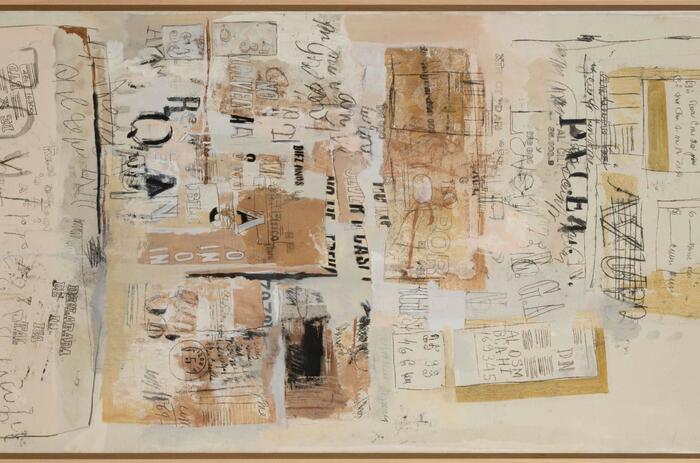
Madrid-based Maisterravalbuena proposes a vindication of the work of Sarah Grilo (Buenos Aires, Argentina,1917 - Madrid, Spain, 2007) through Soluciones para pensar, the second exhibition on this artist at the gallery. With a didactic and rediscovery vocation, the exhibition gathers a selection of paintings in different formats made between the 1960s and 1990s, many of them unpublished to the public. This work of selection and direct work of the gallery with the archive and the legacy of the Argentinean artist becomes fundamental in the structuring of the objective of creating opportunities for a greater knowledge of Grilo's work.
(RE)DISCOVERING SARAH GRILO AT MAISTERRAVALBUENA
Madrid-based Maisterravalbuena proposes a vindication of the work of Sarah Grilo (Buenos Aires, Argentina,1917 - Madrid, Spain, 2007) through Soluciones para pensar, the second exhibition on this artist at the gallery. With a didactic and rediscovery vocation, the exhibition gathers a selection of paintings in different formats made between the 1960s and 1990s, many of them unpublished to the public. This work of selection and direct work of the gallery with the archive and the legacy of the Argentinean artist becomes fundamental in the structuring of the objective of creating opportunities for a greater knowledge of Grilo's work.
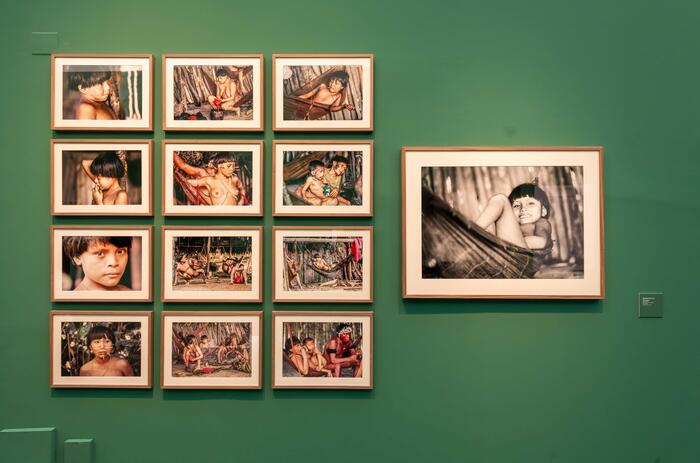
Madrid's CentroCentro approaches the artistic production related to the Amazon with the exhibition Trópico sin tópico: Amazonas (Tropic without Topic: Amazon), curated by Halim Badawi (Barranquilla, Colombia, 1982), and with which it intends to facilitate new looks beyond the usual ones with which the European imaginary contemplates the indigenous legacy and its relation with the contemporary world.
THE REVERSION OF AMAZONIAN CLICHÉS AT CENTROCENTRO
Madrid's CentroCentro approaches the artistic production related to the Amazon with the exhibition Trópico sin tópico: Amazonas (Tropic without Topic: Amazon), curated by Halim Badawi (Barranquilla, Colombia, 1982), and with which it intends to facilitate new looks beyond the usual ones with which the European imaginary contemplates the indigenous legacy and its relation with the contemporary world.
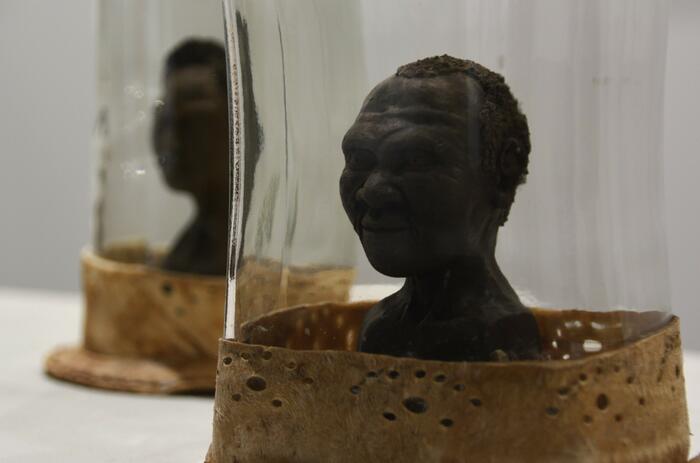
The organization has entrusted Mexican curator José Esparza Chong Cuy with the development of Perfiles | Arte latinoamericano, a curated journey that highlights, through ten selected figures, the diversity of visual approaches. As the curator himself states, it offers "a broad panorama of how to identify as artists and build community, proposing new ways of making, thinking, and living together."
THE LATIN AMERICAN GAZE IN ARCO’S “PROFILES” PROGRAM
The organization has entrusted Mexican curator José Esparza Chong Cuy with the development of Perfiles | Arte latinoamericano, a curated journey that highlights, through ten selected figures, the diversity of visual approaches. As the curator himself states, it offers "a broad panorama of how to identify as artists and build community, proposing new ways of making, thinking, and living together."
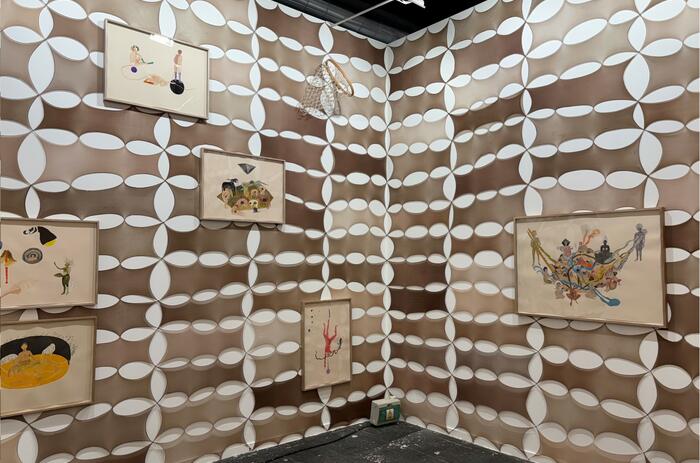
The Museo Nacional Centro de Arte Reina Sofía has announced the acquisitions made during the ARCO fair, through which both the institution and the Ministry of Culture expand the museum’s collections. Among the artists whose work is now part of the Madrid-based institution are Argentine artist Marta Minujín and Colombian artists Juan Pablo Echeverri and Luz Lizarazo—three figures with different career trajectories who bring a distinct Latin American perspective to a list of acquisitions largely focused on Spanish artists.
THE REINA SOFÍA ACQUIRES WORKS BY MINUJÍN, LIZARAZO AND ECHEVERRI AT ARCO FOR ITS COLLECTION
The Museo Nacional Centro de Arte Reina Sofía has announced the acquisitions made during the ARCO fair, through which both the institution and the Ministry of Culture expand the museum’s collections. Among the artists whose work is now part of the Madrid-based institution are Argentine artist Marta Minujín and Colombian artists Juan Pablo Echeverri and Luz Lizarazo—three figures with different career trajectories who bring a distinct Latin American perspective to a list of acquisitions largely focused on Spanish artists.
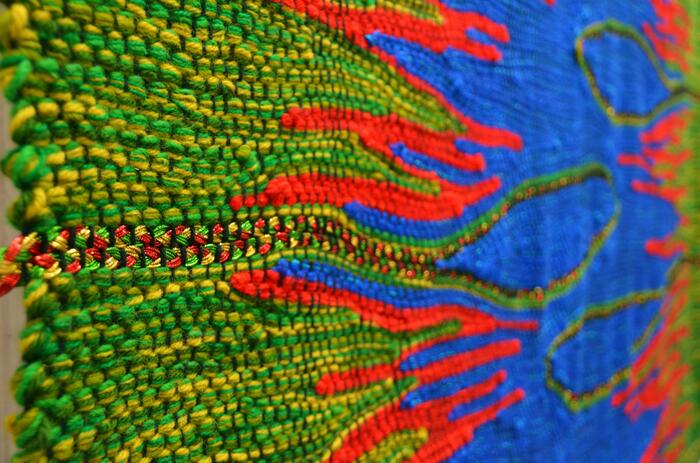
The Latin American presence at ARCO is consolidating year after year, establishing itself as a primary guiding thread beyond market trends, becoming a significant part of the identity of the Madrid fair. In this sense, the participating galleries in the various programs showcase well-established names as well as younger or more radical bets, shaping an ecosystem in which various productions can be analyzed.
ARCO 2025: DIFFERENT VIEWS ON LATIN AMERICA
The Latin American presence at ARCO is consolidating year after year, establishing itself as a primary guiding thread beyond market trends, becoming a significant part of the identity of the Madrid fair. In this sense, the participating galleries in the various programs showcase well-established names as well as younger or more radical bets, shaping an ecosystem in which various productions can be analyzed.
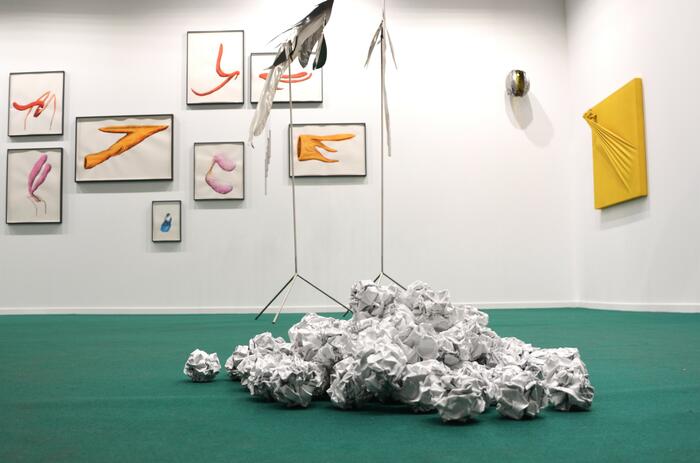
With strong gallery participation, ARCO is an interesting point to measure how the proposals reach the visitor and the collector. The choices based on aesthetic or commercial criteria create synergies that shape a fluid and sometimes circumstantial representation of each catalog. From Arte al Día, we delve into ten of those catalogs, expanded to variegated universes, monographs and dialogues that show a sample of the approach of Latin American galleries in their presence at the Madrid fair.
THE UNIVERSES OF THE LATIN AMERICAN GALLERIES IN ARCO
With strong gallery participation, ARCO is an interesting point to measure how the proposals reach the visitor and the collector. The choices based on aesthetic or commercial criteria create synergies that shape a fluid and sometimes circumstantial representation of each catalog. From Arte al Día, we delve into ten of those catalogs, expanded to variegated universes, monographs and dialogues that show a sample of the approach of Latin American galleries in their presence at the Madrid fair.
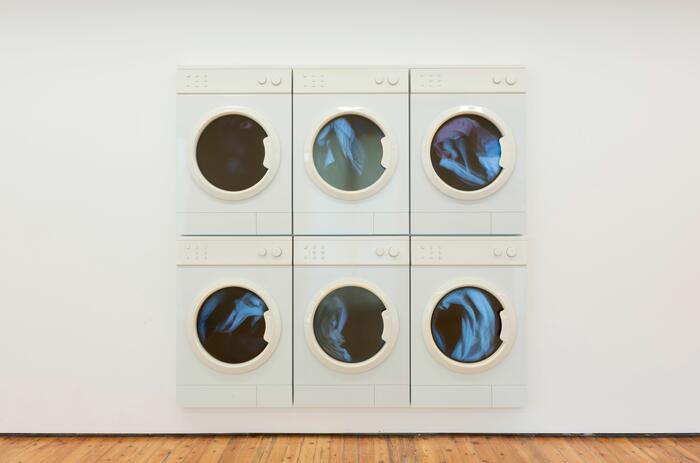
La nevera en la sala (The Fridge in the Living Room) is the arrangement through which Leandro Erlich (Buenos Aires, Argentina, 1973) reinterprets his vision of perception through architecture and everyday life at Prats Nogueras Blanchard. A recurring theme in this Argentine artist’s work, the pieces exhibited at the gallery’s Madrid headquarters do not belong to a new production but rather mark the first public presentation of a series of works that engage with realism and illusion, complemented by their location and functionality within the space.
PERCEPTION AND QUOTIDIANITY IN LEANDRO ERLICH
La nevera en la sala (The Fridge in the Living Room) is the arrangement through which Leandro Erlich (Buenos Aires, Argentina, 1973) reinterprets his vision of perception through architecture and everyday life at Prats Nogueras Blanchard. A recurring theme in this Argentine artist’s work, the pieces exhibited at the gallery’s Madrid headquarters do not belong to a new production but rather mark the first public presentation of a series of works that engage with realism and illusion, complemented by their location and functionality within the space.

The terraces of the Nouvel Building at the Reina Sofía Museum are being transformed into a new exhibition space. Under the title A Different Order: Utopian Geometry and Kinetic Art, the space will showcase two sculptural works by Jesús Rafael Soto and Edgar Negret, along with a third piece by Martín Chirino.
SOTO, NEGRET AND CHIRINO LEAD THE REOPENING OF THE REINA SOFÍA TERRACES AS AN EXHIBITION SPACE
The terraces of the Nouvel Building at the Reina Sofía Museum are being transformed into a new exhibition space. Under the title A Different Order: Utopian Geometry and Kinetic Art, the space will showcase two sculptural works by Jesús Rafael Soto and Edgar Negret, along with a third piece by Martín Chirino.

Intricate between action and register, El Apartamento hosts Algo deja quien se va, the first solo exhibition in Spain by Reynier Leyva Novo (Havana, Cuba, 1983). Starting from the political concept of historical memory and linking it to the issues of power and colonialism, the artist unfolds in two well-differentiated series his proposal to approach these lines, and extends his networks to the impact (or influence) they have on the institutional and cultural fabric.
LEYVA NOVO: DUST IT IS AND TO DUST IT WILL TURN
Intricate between action and register, El Apartamento hosts Algo deja quien se va, the first solo exhibition in Spain by Reynier Leyva Novo (Havana, Cuba, 1983). Starting from the political concept of historical memory and linking it to the issues of power and colonialism, the artist unfolds in two well-differentiated series his proposal to approach these lines, and extends his networks to the impact (or influence) they have on the institutional and cultural fabric.

The intervention Wasi Llamkha (Place and touch), by artist Andrea Canepa (Lima, Peru, 1980), stands on the South Patio of Madrid's Condeduque. This pavilion, designed as an ephemeral architectural structure, invites us to explore its sensorial value, far from the preeminence of the visual, and claims, by way of inspiration, the quipus, the forms of representation and recording of information from pre-Columbian Peru.
SPACE AND SENSES IN ANDREA CANEPA
The intervention Wasi Llamkha (Place and touch), by artist Andrea Canepa (Lima, Peru, 1980), stands on the South Patio of Madrid's Condeduque. This pavilion, designed as an ephemeral architectural structure, invites us to explore its sensorial value, far from the preeminence of the visual, and claims, by way of inspiration, the quipus, the forms of representation and recording of information from pre-Columbian Peru.

Madrid-based Maisterravalbuena proposes a vindication of the work of Sarah Grilo (Buenos Aires, Argentina,1917 - Madrid, Spain, 2007) through Soluciones para pensar, the second exhibition on this artist at the gallery. With a didactic and rediscovery vocation, the exhibition gathers a selection of paintings in different formats made between the 1960s and 1990s, many of them unpublished to the public. This work of selection and direct work of the gallery with the archive and the legacy of the Argentinean artist becomes fundamental in the structuring of the objective of creating opportunities for a greater knowledge of Grilo's work.
(RE)DISCOVERING SARAH GRILO AT MAISTERRAVALBUENA
Madrid-based Maisterravalbuena proposes a vindication of the work of Sarah Grilo (Buenos Aires, Argentina,1917 - Madrid, Spain, 2007) through Soluciones para pensar, the second exhibition on this artist at the gallery. With a didactic and rediscovery vocation, the exhibition gathers a selection of paintings in different formats made between the 1960s and 1990s, many of them unpublished to the public. This work of selection and direct work of the gallery with the archive and the legacy of the Argentinean artist becomes fundamental in the structuring of the objective of creating opportunities for a greater knowledge of Grilo's work.

Madrid's CentroCentro approaches the artistic production related to the Amazon with the exhibition Trópico sin tópico: Amazonas (Tropic without Topic: Amazon), curated by Halim Badawi (Barranquilla, Colombia, 1982), and with which it intends to facilitate new looks beyond the usual ones with which the European imaginary contemplates the indigenous legacy and its relation with the contemporary world.
THE REVERSION OF AMAZONIAN CLICHÉS AT CENTROCENTRO
Madrid's CentroCentro approaches the artistic production related to the Amazon with the exhibition Trópico sin tópico: Amazonas (Tropic without Topic: Amazon), curated by Halim Badawi (Barranquilla, Colombia, 1982), and with which it intends to facilitate new looks beyond the usual ones with which the European imaginary contemplates the indigenous legacy and its relation with the contemporary world.

The organization has entrusted Mexican curator José Esparza Chong Cuy with the development of Perfiles | Arte latinoamericano, a curated journey that highlights, through ten selected figures, the diversity of visual approaches. As the curator himself states, it offers "a broad panorama of how to identify as artists and build community, proposing new ways of making, thinking, and living together."
THE LATIN AMERICAN GAZE IN ARCO’S “PROFILES” PROGRAM
The organization has entrusted Mexican curator José Esparza Chong Cuy with the development of Perfiles | Arte latinoamericano, a curated journey that highlights, through ten selected figures, the diversity of visual approaches. As the curator himself states, it offers "a broad panorama of how to identify as artists and build community, proposing new ways of making, thinking, and living together."

The Museo Nacional Centro de Arte Reina Sofía has announced the acquisitions made during the ARCO fair, through which both the institution and the Ministry of Culture expand the museum’s collections. Among the artists whose work is now part of the Madrid-based institution are Argentine artist Marta Minujín and Colombian artists Juan Pablo Echeverri and Luz Lizarazo—three figures with different career trajectories who bring a distinct Latin American perspective to a list of acquisitions largely focused on Spanish artists.
THE REINA SOFÍA ACQUIRES WORKS BY MINUJÍN, LIZARAZO AND ECHEVERRI AT ARCO FOR ITS COLLECTION
The Museo Nacional Centro de Arte Reina Sofía has announced the acquisitions made during the ARCO fair, through which both the institution and the Ministry of Culture expand the museum’s collections. Among the artists whose work is now part of the Madrid-based institution are Argentine artist Marta Minujín and Colombian artists Juan Pablo Echeverri and Luz Lizarazo—three figures with different career trajectories who bring a distinct Latin American perspective to a list of acquisitions largely focused on Spanish artists.

The Latin American presence at ARCO is consolidating year after year, establishing itself as a primary guiding thread beyond market trends, becoming a significant part of the identity of the Madrid fair. In this sense, the participating galleries in the various programs showcase well-established names as well as younger or more radical bets, shaping an ecosystem in which various productions can be analyzed.
ARCO 2025: DIFFERENT VIEWS ON LATIN AMERICA
The Latin American presence at ARCO is consolidating year after year, establishing itself as a primary guiding thread beyond market trends, becoming a significant part of the identity of the Madrid fair. In this sense, the participating galleries in the various programs showcase well-established names as well as younger or more radical bets, shaping an ecosystem in which various productions can be analyzed.

With strong gallery participation, ARCO is an interesting point to measure how the proposals reach the visitor and the collector. The choices based on aesthetic or commercial criteria create synergies that shape a fluid and sometimes circumstantial representation of each catalog. From Arte al Día, we delve into ten of those catalogs, expanded to variegated universes, monographs and dialogues that show a sample of the approach of Latin American galleries in their presence at the Madrid fair.
THE UNIVERSES OF THE LATIN AMERICAN GALLERIES IN ARCO
With strong gallery participation, ARCO is an interesting point to measure how the proposals reach the visitor and the collector. The choices based on aesthetic or commercial criteria create synergies that shape a fluid and sometimes circumstantial representation of each catalog. From Arte al Día, we delve into ten of those catalogs, expanded to variegated universes, monographs and dialogues that show a sample of the approach of Latin American galleries in their presence at the Madrid fair.

La nevera en la sala (The Fridge in the Living Room) is the arrangement through which Leandro Erlich (Buenos Aires, Argentina, 1973) reinterprets his vision of perception through architecture and everyday life at Prats Nogueras Blanchard. A recurring theme in this Argentine artist’s work, the pieces exhibited at the gallery’s Madrid headquarters do not belong to a new production but rather mark the first public presentation of a series of works that engage with realism and illusion, complemented by their location and functionality within the space.
PERCEPTION AND QUOTIDIANITY IN LEANDRO ERLICH
La nevera en la sala (The Fridge in the Living Room) is the arrangement through which Leandro Erlich (Buenos Aires, Argentina, 1973) reinterprets his vision of perception through architecture and everyday life at Prats Nogueras Blanchard. A recurring theme in this Argentine artist’s work, the pieces exhibited at the gallery’s Madrid headquarters do not belong to a new production but rather mark the first public presentation of a series of works that engage with realism and illusion, complemented by their location and functionality within the space.

The terraces of the Nouvel Building at the Reina Sofía Museum are being transformed into a new exhibition space. Under the title A Different Order: Utopian Geometry and Kinetic Art, the space will showcase two sculptural works by Jesús Rafael Soto and Edgar Negret, along with a third piece by Martín Chirino.
SOTO, NEGRET AND CHIRINO LEAD THE REOPENING OF THE REINA SOFÍA TERRACES AS AN EXHIBITION SPACE
The terraces of the Nouvel Building at the Reina Sofía Museum are being transformed into a new exhibition space. Under the title A Different Order: Utopian Geometry and Kinetic Art, the space will showcase two sculptural works by Jesús Rafael Soto and Edgar Negret, along with a third piece by Martín Chirino.

Intricate between action and register, El Apartamento hosts Algo deja quien se va, the first solo exhibition in Spain by Reynier Leyva Novo (Havana, Cuba, 1983). Starting from the political concept of historical memory and linking it to the issues of power and colonialism, the artist unfolds in two well-differentiated series his proposal to approach these lines, and extends his networks to the impact (or influence) they have on the institutional and cultural fabric.
LEYVA NOVO: DUST IT IS AND TO DUST IT WILL TURN
Intricate between action and register, El Apartamento hosts Algo deja quien se va, the first solo exhibition in Spain by Reynier Leyva Novo (Havana, Cuba, 1983). Starting from the political concept of historical memory and linking it to the issues of power and colonialism, the artist unfolds in two well-differentiated series his proposal to approach these lines, and extends his networks to the impact (or influence) they have on the institutional and cultural fabric.

The intervention Wasi Llamkha (Place and touch), by artist Andrea Canepa (Lima, Peru, 1980), stands on the South Patio of Madrid's Condeduque. This pavilion, designed as an ephemeral architectural structure, invites us to explore its sensorial value, far from the preeminence of the visual, and claims, by way of inspiration, the quipus, the forms of representation and recording of information from pre-Columbian Peru.
SPACE AND SENSES IN ANDREA CANEPA
The intervention Wasi Llamkha (Place and touch), by artist Andrea Canepa (Lima, Peru, 1980), stands on the South Patio of Madrid's Condeduque. This pavilion, designed as an ephemeral architectural structure, invites us to explore its sensorial value, far from the preeminence of the visual, and claims, by way of inspiration, the quipus, the forms of representation and recording of information from pre-Columbian Peru.

Madrid-based Maisterravalbuena proposes a vindication of the work of Sarah Grilo (Buenos Aires, Argentina,1917 - Madrid, Spain, 2007) through Soluciones para pensar, the second exhibition on this artist at the gallery. With a didactic and rediscovery vocation, the exhibition gathers a selection of paintings in different formats made between the 1960s and 1990s, many of them unpublished to the public. This work of selection and direct work of the gallery with the archive and the legacy of the Argentinean artist becomes fundamental in the structuring of the objective of creating opportunities for a greater knowledge of Grilo's work.
(RE)DISCOVERING SARAH GRILO AT MAISTERRAVALBUENA
Madrid-based Maisterravalbuena proposes a vindication of the work of Sarah Grilo (Buenos Aires, Argentina,1917 - Madrid, Spain, 2007) through Soluciones para pensar, the second exhibition on this artist at the gallery. With a didactic and rediscovery vocation, the exhibition gathers a selection of paintings in different formats made between the 1960s and 1990s, many of them unpublished to the public. This work of selection and direct work of the gallery with the archive and the legacy of the Argentinean artist becomes fundamental in the structuring of the objective of creating opportunities for a greater knowledge of Grilo's work.

Madrid's CentroCentro approaches the artistic production related to the Amazon with the exhibition Trópico sin tópico: Amazonas (Tropic without Topic: Amazon), curated by Halim Badawi (Barranquilla, Colombia, 1982), and with which it intends to facilitate new looks beyond the usual ones with which the European imaginary contemplates the indigenous legacy and its relation with the contemporary world.
THE REVERSION OF AMAZONIAN CLICHÉS AT CENTROCENTRO
Madrid's CentroCentro approaches the artistic production related to the Amazon with the exhibition Trópico sin tópico: Amazonas (Tropic without Topic: Amazon), curated by Halim Badawi (Barranquilla, Colombia, 1982), and with which it intends to facilitate new looks beyond the usual ones with which the European imaginary contemplates the indigenous legacy and its relation with the contemporary world.

The organization has entrusted Mexican curator José Esparza Chong Cuy with the development of Perfiles | Arte latinoamericano, a curated journey that highlights, through ten selected figures, the diversity of visual approaches. As the curator himself states, it offers "a broad panorama of how to identify as artists and build community, proposing new ways of making, thinking, and living together."
THE LATIN AMERICAN GAZE IN ARCO’S “PROFILES” PROGRAM
The organization has entrusted Mexican curator José Esparza Chong Cuy with the development of Perfiles | Arte latinoamericano, a curated journey that highlights, through ten selected figures, the diversity of visual approaches. As the curator himself states, it offers "a broad panorama of how to identify as artists and build community, proposing new ways of making, thinking, and living together."

The Museo Nacional Centro de Arte Reina Sofía has announced the acquisitions made during the ARCO fair, through which both the institution and the Ministry of Culture expand the museum’s collections. Among the artists whose work is now part of the Madrid-based institution are Argentine artist Marta Minujín and Colombian artists Juan Pablo Echeverri and Luz Lizarazo—three figures with different career trajectories who bring a distinct Latin American perspective to a list of acquisitions largely focused on Spanish artists.
THE REINA SOFÍA ACQUIRES WORKS BY MINUJÍN, LIZARAZO AND ECHEVERRI AT ARCO FOR ITS COLLECTION
The Museo Nacional Centro de Arte Reina Sofía has announced the acquisitions made during the ARCO fair, through which both the institution and the Ministry of Culture expand the museum’s collections. Among the artists whose work is now part of the Madrid-based institution are Argentine artist Marta Minujín and Colombian artists Juan Pablo Echeverri and Luz Lizarazo—three figures with different career trajectories who bring a distinct Latin American perspective to a list of acquisitions largely focused on Spanish artists.

The Latin American presence at ARCO is consolidating year after year, establishing itself as a primary guiding thread beyond market trends, becoming a significant part of the identity of the Madrid fair. In this sense, the participating galleries in the various programs showcase well-established names as well as younger or more radical bets, shaping an ecosystem in which various productions can be analyzed.
ARCO 2025: DIFFERENT VIEWS ON LATIN AMERICA
The Latin American presence at ARCO is consolidating year after year, establishing itself as a primary guiding thread beyond market trends, becoming a significant part of the identity of the Madrid fair. In this sense, the participating galleries in the various programs showcase well-established names as well as younger or more radical bets, shaping an ecosystem in which various productions can be analyzed.

With strong gallery participation, ARCO is an interesting point to measure how the proposals reach the visitor and the collector. The choices based on aesthetic or commercial criteria create synergies that shape a fluid and sometimes circumstantial representation of each catalog. From Arte al Día, we delve into ten of those catalogs, expanded to variegated universes, monographs and dialogues that show a sample of the approach of Latin American galleries in their presence at the Madrid fair.
THE UNIVERSES OF THE LATIN AMERICAN GALLERIES IN ARCO
With strong gallery participation, ARCO is an interesting point to measure how the proposals reach the visitor and the collector. The choices based on aesthetic or commercial criteria create synergies that shape a fluid and sometimes circumstantial representation of each catalog. From Arte al Día, we delve into ten of those catalogs, expanded to variegated universes, monographs and dialogues that show a sample of the approach of Latin American galleries in their presence at the Madrid fair.

La nevera en la sala (The Fridge in the Living Room) is the arrangement through which Leandro Erlich (Buenos Aires, Argentina, 1973) reinterprets his vision of perception through architecture and everyday life at Prats Nogueras Blanchard. A recurring theme in this Argentine artist’s work, the pieces exhibited at the gallery’s Madrid headquarters do not belong to a new production but rather mark the first public presentation of a series of works that engage with realism and illusion, complemented by their location and functionality within the space.
PERCEPTION AND QUOTIDIANITY IN LEANDRO ERLICH
La nevera en la sala (The Fridge in the Living Room) is the arrangement through which Leandro Erlich (Buenos Aires, Argentina, 1973) reinterprets his vision of perception through architecture and everyday life at Prats Nogueras Blanchard. A recurring theme in this Argentine artist’s work, the pieces exhibited at the gallery’s Madrid headquarters do not belong to a new production but rather mark the first public presentation of a series of works that engage with realism and illusion, complemented by their location and functionality within the space.

The terraces of the Nouvel Building at the Reina Sofía Museum are being transformed into a new exhibition space. Under the title A Different Order: Utopian Geometry and Kinetic Art, the space will showcase two sculptural works by Jesús Rafael Soto and Edgar Negret, along with a third piece by Martín Chirino.
SOTO, NEGRET AND CHIRINO LEAD THE REOPENING OF THE REINA SOFÍA TERRACES AS AN EXHIBITION SPACE
The terraces of the Nouvel Building at the Reina Sofía Museum are being transformed into a new exhibition space. Under the title A Different Order: Utopian Geometry and Kinetic Art, the space will showcase two sculptural works by Jesús Rafael Soto and Edgar Negret, along with a third piece by Martín Chirino.

Intricate between action and register, El Apartamento hosts Algo deja quien se va, the first solo exhibition in Spain by Reynier Leyva Novo (Havana, Cuba, 1983). Starting from the political concept of historical memory and linking it to the issues of power and colonialism, the artist unfolds in two well-differentiated series his proposal to approach these lines, and extends his networks to the impact (or influence) they have on the institutional and cultural fabric.
LEYVA NOVO: DUST IT IS AND TO DUST IT WILL TURN
Intricate between action and register, El Apartamento hosts Algo deja quien se va, the first solo exhibition in Spain by Reynier Leyva Novo (Havana, Cuba, 1983). Starting from the political concept of historical memory and linking it to the issues of power and colonialism, the artist unfolds in two well-differentiated series his proposal to approach these lines, and extends his networks to the impact (or influence) they have on the institutional and cultural fabric.

The intervention Wasi Llamkha (Place and touch), by artist Andrea Canepa (Lima, Peru, 1980), stands on the South Patio of Madrid's Condeduque. This pavilion, designed as an ephemeral architectural structure, invites us to explore its sensorial value, far from the preeminence of the visual, and claims, by way of inspiration, the quipus, the forms of representation and recording of information from pre-Columbian Peru.
SPACE AND SENSES IN ANDREA CANEPA
The intervention Wasi Llamkha (Place and touch), by artist Andrea Canepa (Lima, Peru, 1980), stands on the South Patio of Madrid's Condeduque. This pavilion, designed as an ephemeral architectural structure, invites us to explore its sensorial value, far from the preeminence of the visual, and claims, by way of inspiration, the quipus, the forms of representation and recording of information from pre-Columbian Peru.

Madrid-based Maisterravalbuena proposes a vindication of the work of Sarah Grilo (Buenos Aires, Argentina,1917 - Madrid, Spain, 2007) through Soluciones para pensar, the second exhibition on this artist at the gallery. With a didactic and rediscovery vocation, the exhibition gathers a selection of paintings in different formats made between the 1960s and 1990s, many of them unpublished to the public. This work of selection and direct work of the gallery with the archive and the legacy of the Argentinean artist becomes fundamental in the structuring of the objective of creating opportunities for a greater knowledge of Grilo's work.
(RE)DISCOVERING SARAH GRILO AT MAISTERRAVALBUENA
Madrid-based Maisterravalbuena proposes a vindication of the work of Sarah Grilo (Buenos Aires, Argentina,1917 - Madrid, Spain, 2007) through Soluciones para pensar, the second exhibition on this artist at the gallery. With a didactic and rediscovery vocation, the exhibition gathers a selection of paintings in different formats made between the 1960s and 1990s, many of them unpublished to the public. This work of selection and direct work of the gallery with the archive and the legacy of the Argentinean artist becomes fundamental in the structuring of the objective of creating opportunities for a greater knowledge of Grilo's work.

Madrid's CentroCentro approaches the artistic production related to the Amazon with the exhibition Trópico sin tópico: Amazonas (Tropic without Topic: Amazon), curated by Halim Badawi (Barranquilla, Colombia, 1982), and with which it intends to facilitate new looks beyond the usual ones with which the European imaginary contemplates the indigenous legacy and its relation with the contemporary world.
THE REVERSION OF AMAZONIAN CLICHÉS AT CENTROCENTRO
Madrid's CentroCentro approaches the artistic production related to the Amazon with the exhibition Trópico sin tópico: Amazonas (Tropic without Topic: Amazon), curated by Halim Badawi (Barranquilla, Colombia, 1982), and with which it intends to facilitate new looks beyond the usual ones with which the European imaginary contemplates the indigenous legacy and its relation with the contemporary world.

The organization has entrusted Mexican curator José Esparza Chong Cuy with the development of Perfiles | Arte latinoamericano, a curated journey that highlights, through ten selected figures, the diversity of visual approaches. As the curator himself states, it offers "a broad panorama of how to identify as artists and build community, proposing new ways of making, thinking, and living together."
THE LATIN AMERICAN GAZE IN ARCO’S “PROFILES” PROGRAM
The organization has entrusted Mexican curator José Esparza Chong Cuy with the development of Perfiles | Arte latinoamericano, a curated journey that highlights, through ten selected figures, the diversity of visual approaches. As the curator himself states, it offers "a broad panorama of how to identify as artists and build community, proposing new ways of making, thinking, and living together."

The Museo Nacional Centro de Arte Reina Sofía has announced the acquisitions made during the ARCO fair, through which both the institution and the Ministry of Culture expand the museum’s collections. Among the artists whose work is now part of the Madrid-based institution are Argentine artist Marta Minujín and Colombian artists Juan Pablo Echeverri and Luz Lizarazo—three figures with different career trajectories who bring a distinct Latin American perspective to a list of acquisitions largely focused on Spanish artists.
THE REINA SOFÍA ACQUIRES WORKS BY MINUJÍN, LIZARAZO AND ECHEVERRI AT ARCO FOR ITS COLLECTION
The Museo Nacional Centro de Arte Reina Sofía has announced the acquisitions made during the ARCO fair, through which both the institution and the Ministry of Culture expand the museum’s collections. Among the artists whose work is now part of the Madrid-based institution are Argentine artist Marta Minujín and Colombian artists Juan Pablo Echeverri and Luz Lizarazo—three figures with different career trajectories who bring a distinct Latin American perspective to a list of acquisitions largely focused on Spanish artists.

The Latin American presence at ARCO is consolidating year after year, establishing itself as a primary guiding thread beyond market trends, becoming a significant part of the identity of the Madrid fair. In this sense, the participating galleries in the various programs showcase well-established names as well as younger or more radical bets, shaping an ecosystem in which various productions can be analyzed.
ARCO 2025: DIFFERENT VIEWS ON LATIN AMERICA
The Latin American presence at ARCO is consolidating year after year, establishing itself as a primary guiding thread beyond market trends, becoming a significant part of the identity of the Madrid fair. In this sense, the participating galleries in the various programs showcase well-established names as well as younger or more radical bets, shaping an ecosystem in which various productions can be analyzed.

With strong gallery participation, ARCO is an interesting point to measure how the proposals reach the visitor and the collector. The choices based on aesthetic or commercial criteria create synergies that shape a fluid and sometimes circumstantial representation of each catalog. From Arte al Día, we delve into ten of those catalogs, expanded to variegated universes, monographs and dialogues that show a sample of the approach of Latin American galleries in their presence at the Madrid fair.
THE UNIVERSES OF THE LATIN AMERICAN GALLERIES IN ARCO
With strong gallery participation, ARCO is an interesting point to measure how the proposals reach the visitor and the collector. The choices based on aesthetic or commercial criteria create synergies that shape a fluid and sometimes circumstantial representation of each catalog. From Arte al Día, we delve into ten of those catalogs, expanded to variegated universes, monographs and dialogues that show a sample of the approach of Latin American galleries in their presence at the Madrid fair.

La nevera en la sala (The Fridge in the Living Room) is the arrangement through which Leandro Erlich (Buenos Aires, Argentina, 1973) reinterprets his vision of perception through architecture and everyday life at Prats Nogueras Blanchard. A recurring theme in this Argentine artist’s work, the pieces exhibited at the gallery’s Madrid headquarters do not belong to a new production but rather mark the first public presentation of a series of works that engage with realism and illusion, complemented by their location and functionality within the space.
PERCEPTION AND QUOTIDIANITY IN LEANDRO ERLICH
La nevera en la sala (The Fridge in the Living Room) is the arrangement through which Leandro Erlich (Buenos Aires, Argentina, 1973) reinterprets his vision of perception through architecture and everyday life at Prats Nogueras Blanchard. A recurring theme in this Argentine artist’s work, the pieces exhibited at the gallery’s Madrid headquarters do not belong to a new production but rather mark the first public presentation of a series of works that engage with realism and illusion, complemented by their location and functionality within the space.

The terraces of the Nouvel Building at the Reina Sofía Museum are being transformed into a new exhibition space. Under the title A Different Order: Utopian Geometry and Kinetic Art, the space will showcase two sculptural works by Jesús Rafael Soto and Edgar Negret, along with a third piece by Martín Chirino.
SOTO, NEGRET AND CHIRINO LEAD THE REOPENING OF THE REINA SOFÍA TERRACES AS AN EXHIBITION SPACE
The terraces of the Nouvel Building at the Reina Sofía Museum are being transformed into a new exhibition space. Under the title A Different Order: Utopian Geometry and Kinetic Art, the space will showcase two sculptural works by Jesús Rafael Soto and Edgar Negret, along with a third piece by Martín Chirino.

Intricate between action and register, El Apartamento hosts Algo deja quien se va, the first solo exhibition in Spain by Reynier Leyva Novo (Havana, Cuba, 1983). Starting from the political concept of historical memory and linking it to the issues of power and colonialism, the artist unfolds in two well-differentiated series his proposal to approach these lines, and extends his networks to the impact (or influence) they have on the institutional and cultural fabric.
LEYVA NOVO: DUST IT IS AND TO DUST IT WILL TURN
Intricate between action and register, El Apartamento hosts Algo deja quien se va, the first solo exhibition in Spain by Reynier Leyva Novo (Havana, Cuba, 1983). Starting from the political concept of historical memory and linking it to the issues of power and colonialism, the artist unfolds in two well-differentiated series his proposal to approach these lines, and extends his networks to the impact (or influence) they have on the institutional and cultural fabric.

The intervention Wasi Llamkha (Place and touch), by artist Andrea Canepa (Lima, Peru, 1980), stands on the South Patio of Madrid's Condeduque. This pavilion, designed as an ephemeral architectural structure, invites us to explore its sensorial value, far from the preeminence of the visual, and claims, by way of inspiration, the quipus, the forms of representation and recording of information from pre-Columbian Peru.
SPACE AND SENSES IN ANDREA CANEPA
The intervention Wasi Llamkha (Place and touch), by artist Andrea Canepa (Lima, Peru, 1980), stands on the South Patio of Madrid's Condeduque. This pavilion, designed as an ephemeral architectural structure, invites us to explore its sensorial value, far from the preeminence of the visual, and claims, by way of inspiration, the quipus, the forms of representation and recording of information from pre-Columbian Peru.

Madrid-based Maisterravalbuena proposes a vindication of the work of Sarah Grilo (Buenos Aires, Argentina,1917 - Madrid, Spain, 2007) through Soluciones para pensar, the second exhibition on this artist at the gallery. With a didactic and rediscovery vocation, the exhibition gathers a selection of paintings in different formats made between the 1960s and 1990s, many of them unpublished to the public. This work of selection and direct work of the gallery with the archive and the legacy of the Argentinean artist becomes fundamental in the structuring of the objective of creating opportunities for a greater knowledge of Grilo's work.
(RE)DISCOVERING SARAH GRILO AT MAISTERRAVALBUENA
Madrid-based Maisterravalbuena proposes a vindication of the work of Sarah Grilo (Buenos Aires, Argentina,1917 - Madrid, Spain, 2007) through Soluciones para pensar, the second exhibition on this artist at the gallery. With a didactic and rediscovery vocation, the exhibition gathers a selection of paintings in different formats made between the 1960s and 1990s, many of them unpublished to the public. This work of selection and direct work of the gallery with the archive and the legacy of the Argentinean artist becomes fundamental in the structuring of the objective of creating opportunities for a greater knowledge of Grilo's work.

Madrid's CentroCentro approaches the artistic production related to the Amazon with the exhibition Trópico sin tópico: Amazonas (Tropic without Topic: Amazon), curated by Halim Badawi (Barranquilla, Colombia, 1982), and with which it intends to facilitate new looks beyond the usual ones with which the European imaginary contemplates the indigenous legacy and its relation with the contemporary world.
THE REVERSION OF AMAZONIAN CLICHÉS AT CENTROCENTRO
Madrid's CentroCentro approaches the artistic production related to the Amazon with the exhibition Trópico sin tópico: Amazonas (Tropic without Topic: Amazon), curated by Halim Badawi (Barranquilla, Colombia, 1982), and with which it intends to facilitate new looks beyond the usual ones with which the European imaginary contemplates the indigenous legacy and its relation with the contemporary world.

The organization has entrusted Mexican curator José Esparza Chong Cuy with the development of Perfiles | Arte latinoamericano, a curated journey that highlights, through ten selected figures, the diversity of visual approaches. As the curator himself states, it offers "a broad panorama of how to identify as artists and build community, proposing new ways of making, thinking, and living together."
THE LATIN AMERICAN GAZE IN ARCO’S “PROFILES” PROGRAM
The organization has entrusted Mexican curator José Esparza Chong Cuy with the development of Perfiles | Arte latinoamericano, a curated journey that highlights, through ten selected figures, the diversity of visual approaches. As the curator himself states, it offers "a broad panorama of how to identify as artists and build community, proposing new ways of making, thinking, and living together."

The Museo Nacional Centro de Arte Reina Sofía has announced the acquisitions made during the ARCO fair, through which both the institution and the Ministry of Culture expand the museum’s collections. Among the artists whose work is now part of the Madrid-based institution are Argentine artist Marta Minujín and Colombian artists Juan Pablo Echeverri and Luz Lizarazo—three figures with different career trajectories who bring a distinct Latin American perspective to a list of acquisitions largely focused on Spanish artists.
THE REINA SOFÍA ACQUIRES WORKS BY MINUJÍN, LIZARAZO AND ECHEVERRI AT ARCO FOR ITS COLLECTION
The Museo Nacional Centro de Arte Reina Sofía has announced the acquisitions made during the ARCO fair, through which both the institution and the Ministry of Culture expand the museum’s collections. Among the artists whose work is now part of the Madrid-based institution are Argentine artist Marta Minujín and Colombian artists Juan Pablo Echeverri and Luz Lizarazo—three figures with different career trajectories who bring a distinct Latin American perspective to a list of acquisitions largely focused on Spanish artists.

The Latin American presence at ARCO is consolidating year after year, establishing itself as a primary guiding thread beyond market trends, becoming a significant part of the identity of the Madrid fair. In this sense, the participating galleries in the various programs showcase well-established names as well as younger or more radical bets, shaping an ecosystem in which various productions can be analyzed.
ARCO 2025: DIFFERENT VIEWS ON LATIN AMERICA
The Latin American presence at ARCO is consolidating year after year, establishing itself as a primary guiding thread beyond market trends, becoming a significant part of the identity of the Madrid fair. In this sense, the participating galleries in the various programs showcase well-established names as well as younger or more radical bets, shaping an ecosystem in which various productions can be analyzed.

With strong gallery participation, ARCO is an interesting point to measure how the proposals reach the visitor and the collector. The choices based on aesthetic or commercial criteria create synergies that shape a fluid and sometimes circumstantial representation of each catalog. From Arte al Día, we delve into ten of those catalogs, expanded to variegated universes, monographs and dialogues that show a sample of the approach of Latin American galleries in their presence at the Madrid fair.
THE UNIVERSES OF THE LATIN AMERICAN GALLERIES IN ARCO
With strong gallery participation, ARCO is an interesting point to measure how the proposals reach the visitor and the collector. The choices based on aesthetic or commercial criteria create synergies that shape a fluid and sometimes circumstantial representation of each catalog. From Arte al Día, we delve into ten of those catalogs, expanded to variegated universes, monographs and dialogues that show a sample of the approach of Latin American galleries in their presence at the Madrid fair.

La nevera en la sala (The Fridge in the Living Room) is the arrangement through which Leandro Erlich (Buenos Aires, Argentina, 1973) reinterprets his vision of perception through architecture and everyday life at Prats Nogueras Blanchard. A recurring theme in this Argentine artist’s work, the pieces exhibited at the gallery’s Madrid headquarters do not belong to a new production but rather mark the first public presentation of a series of works that engage with realism and illusion, complemented by their location and functionality within the space.
PERCEPTION AND QUOTIDIANITY IN LEANDRO ERLICH
La nevera en la sala (The Fridge in the Living Room) is the arrangement through which Leandro Erlich (Buenos Aires, Argentina, 1973) reinterprets his vision of perception through architecture and everyday life at Prats Nogueras Blanchard. A recurring theme in this Argentine artist’s work, the pieces exhibited at the gallery’s Madrid headquarters do not belong to a new production but rather mark the first public presentation of a series of works that engage with realism and illusion, complemented by their location and functionality within the space.

The terraces of the Nouvel Building at the Reina Sofía Museum are being transformed into a new exhibition space. Under the title A Different Order: Utopian Geometry and Kinetic Art, the space will showcase two sculptural works by Jesús Rafael Soto and Edgar Negret, along with a third piece by Martín Chirino.
SOTO, NEGRET AND CHIRINO LEAD THE REOPENING OF THE REINA SOFÍA TERRACES AS AN EXHIBITION SPACE
The terraces of the Nouvel Building at the Reina Sofía Museum are being transformed into a new exhibition space. Under the title A Different Order: Utopian Geometry and Kinetic Art, the space will showcase two sculptural works by Jesús Rafael Soto and Edgar Negret, along with a third piece by Martín Chirino.




